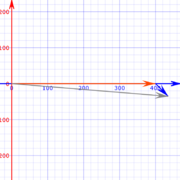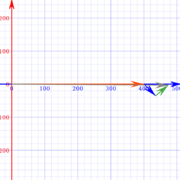Calculus III Advanced (Course) (11.1) (Homework)
Contents
- 1 Section 11.1 Homework
- 1.1 Exercise 11.1.8 Show that vectors u and v are equivalent
- 1.2 Exercise 11.1.28 Find the Terminal Point
- 1.3 Exercise 11.1.36 Find the unit vector in v's direction and verify that it has length 1
- 1.4 Exercise 11.1.50 Find the component form for v, given its magnitude and angle the positive \(x\)-axis.
- 1.5 Exercise 11.1.84 Navigation
- 2 Internal Links
Section 11.1 Homework
From Calculus 10e by Larson and Edwards, p. 755. Exercises 8, 28, 36, 50, 84.
Exercise 11.1.8 Show that vectors u and v are equivalent
u (-4,-1), (11,-4)
v (10,13), (25,10)
Solution Since vectors are line segments the length, magnitude, and slope, direction must match.
| Distance | \(=\sqrt{(x_{2}-x_{1})^{2}+(y_{2}-y_{1})^{2}} \) |
| u | \(= \sqrt{(-4-11)^{2}+(-1-(-4))^{2}} \) |
| \(= \sqrt{(-15)^{2}+(3)^{2}} = \sqrt{ 234 } \) | |
| v | \(= \sqrt{(10-25)^{2}+(13-10)^{2}} \) |
| \(= \sqrt{(-15)^{2}+(3)^{2}} = \sqrt{ 234 } \) |
| Slope | $$= \frac{x_{2}-x_{1}}{y_{2}-y_{1}} $$ |
| u | $$= \frac{-1-(-4)}{-4-11} $$ |
| $$ = \frac{3}{-15} = - \frac{1}{5} $$ | |
| v | $$= \frac{13-10}{10-25} $$ |
| $$ = \frac{3}{-15} = - \frac{1}{5} $$ |
The vectors u and v are equivalent because they have the same length and slope.
Exercise 11.1.28 Find the Terminal Point
Find a terminal point, given \( \textbf{v}= \left \langle 4,-9 \right \rangle \); Initial point: (5,3).
The terminal point is:
- \( (4 + 5, -9 + 3) = (9,-6) \)
Exercise 11.1.36 Find the unit vector in v's direction and verify that it has length 1
Let \( \textbf{v}= \left \langle -5,15 \right \rangle \).
| $$ \frac{\textbf{v}}{\left \| \textbf{v} \right \|} $$ | $$= \frac{ \left \langle -5,15 \right \rangle }{\sqrt{(-5)^{2}+(15)^{2}}}$$ |
| $$=\frac{1}{\sqrt{250}}\left \langle -5,15 \right \rangle $$ | |
| $$= \left \langle \frac{-5}{\sqrt{250}},\frac{15}{\sqrt{250}} \right \rangle$$ | |
| Substitute this into the proof for Theorem 11.1.2 yields. | |
| $$= \sqrt{ \left(\frac{-5}{\sqrt{250}}\right)^{2} + \left(\frac{15}{\sqrt{250}}\right)^{2} }$$ | |
| $$= \sqrt{ \frac{25}{250}+\frac{225}{250}} $$ | |
| $$= \sqrt{\frac{250}{250}} = 1$$ | |
Exercise 11.1.50 Find the component form for v, given its magnitude and angle the positive \(x\)-axis.
Let \(\left \| \textbf{v} \right \| = 3\) and \(\theta = 120^{\circ} \).
Because the angle between v and the positive \(x\)-axis is \(\theta = 2\pi /3 \) the vector can be described as
| \(\textbf{v} \) | \(=\left \| \textbf{v} \right \|\cos \theta\:\textbf{i} + \left \| \textbf{v} \right \| \sin \theta \:\textbf{j}\). |
| $$=3 \cos \frac{2\pi}{3}\textbf{i} + 3 \sin \frac{2\pi}{3}\textbf{j} $$ | |
| $$= -\frac{3}{2}\textbf{i} + \frac{3\sqrt{3}}{2}\textbf{j} $$ |
|
|
A plane flies at a 400 mph constant ground speed due east, 90°. A 50-mile-per-hour wind hits the plane from the northwest, 135°. Let \( \textbf{v}_{1}\) be the airplane's vector. Let \( \textbf{v}_{2}\) be the wind's vector. Let \( \textbf{v}_{3}\) be the combined vectors that represent the airplane's new course. Let \( \textbf{v}_{4}\) be the airplane's corrected course.
As shown in Figure 11.2. | ||||||||||||||||||||||||||
Internal Links
Parent Article: Calculus III Advanced (Course)

